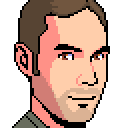Perfect: The Enemy of Good
The year is 2003, and I am in senior year of high school. I’d downloaded a copy of RPG Maker, and was using it to make a game based around people from the school. They were asking about the game, so I wrote a simple website and hosted it on a free web hosting platform. It was written in HTML with all the bells and whistles available at the time: styles went directly onto elements, marquee tags, frames. It went over well with my peers, and I had fun making it. I started to think about how much fun it would be to make my own website, but I didn’t go much further than that.
The year is 2006, and I am at university studying Computer Science. I’d taken an interest in the niche hobby of case modding. I had become a regular on the forums of Paul Capello, one of the more well-known ‘modders’ of the time. Eventually I got involved in running the site itself, and spearheaded several initiatives to improve security, clean up the UI, that sort of thing. I enjoyed writing, and I was producing so much content that I started to think about building my own website using PHP, MySQL and CSS. CSS wasn’t new, but it did seem complex; especially in the early days when browser support was patchy at best. Before this we’d all used the HTML Table tags to build complicated layouts. This sounds mad, but if you had a visual HTML editor of some kind, it wasn’t too bad. Table properties could be leveraged to make a website handle different browser sizes, which was a game changer at a time when many websites would have a footer telling you “best viewed in Internet Explorer at 1024x768”. In the shiny new CSS world, this was frowned upon as it meant the HTML didn’t have appropriate semantics. Of course, this is what Tim-Berners Lee had always wanted for the internet, but the whole thing went off the rails with the Browser Wars.
“The Semantic Web is not a separate Web but an extension of the current one, in which information is given well-defined meaning, better enabling computers and people to work in cooperation.”
Tim-Berners Lee1
The year is 2008, and while I am doing well at university, I am in extremely poor health due to chronic Ulcerative Collitis. To cope with this, I had been throwing myself into various projects. On such project was the creation of a “worklog” tool for University, which was essentially a fully-realised PHP based website where users can start “worklogs”. A worklog is essentially a series of articles called ‘entries’, each of which has a separate comments section at the bottom. The intended use case is that a person can start a worklog and add entries whenever they have an update on the project. As each entry has its own comments section, comments are relevant to the post, and users can read only the entries if they don’t care about the discussion. It seemed to solve many problems faced by people using forum software in various hobbies, and I had planned on using it as the basis of my own website. Unfortunately I had a difficult time explaining it to my lecturers, who kept asking me if it was a message board or a chat room, not seeming to grasp that it was neither.
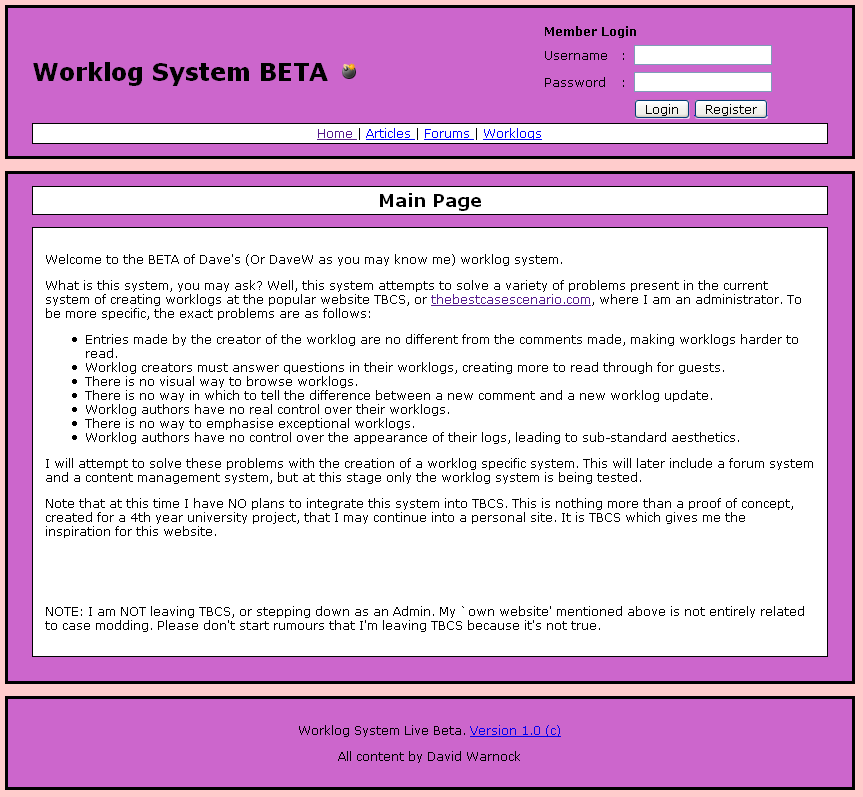
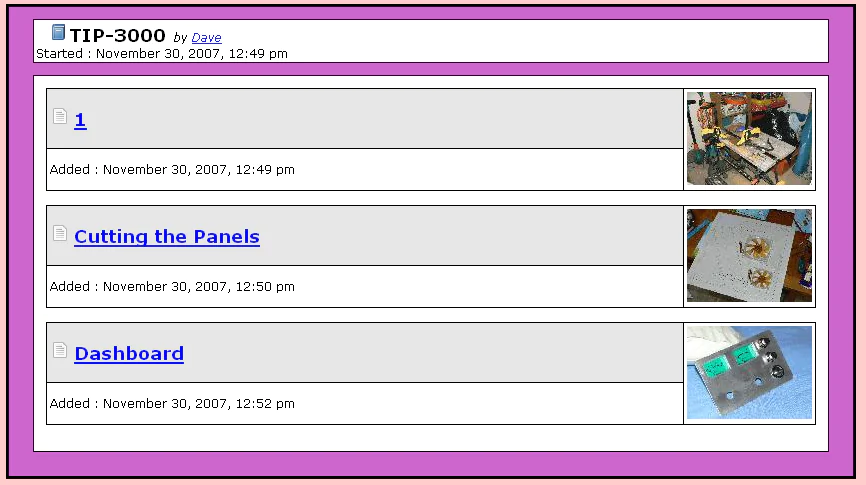
The year is 2009, and I am recovering from several significant operations for my chronic illness. I took notes of my experiences, intending to put them on my website, but things essentially grind to a halt while I recover. I have some articles, a “modern” design (for the time) and most of a website written. But it was fragmented, and I struggled pull it all together into a cohesive whole. The articles were just text documents in a folder, while the website used placeholders everywhere. At some point I stopped working on it altogether. However, there was at least one crucial development in 2009: this is the year that I purchased my domain, davewarnock.com.
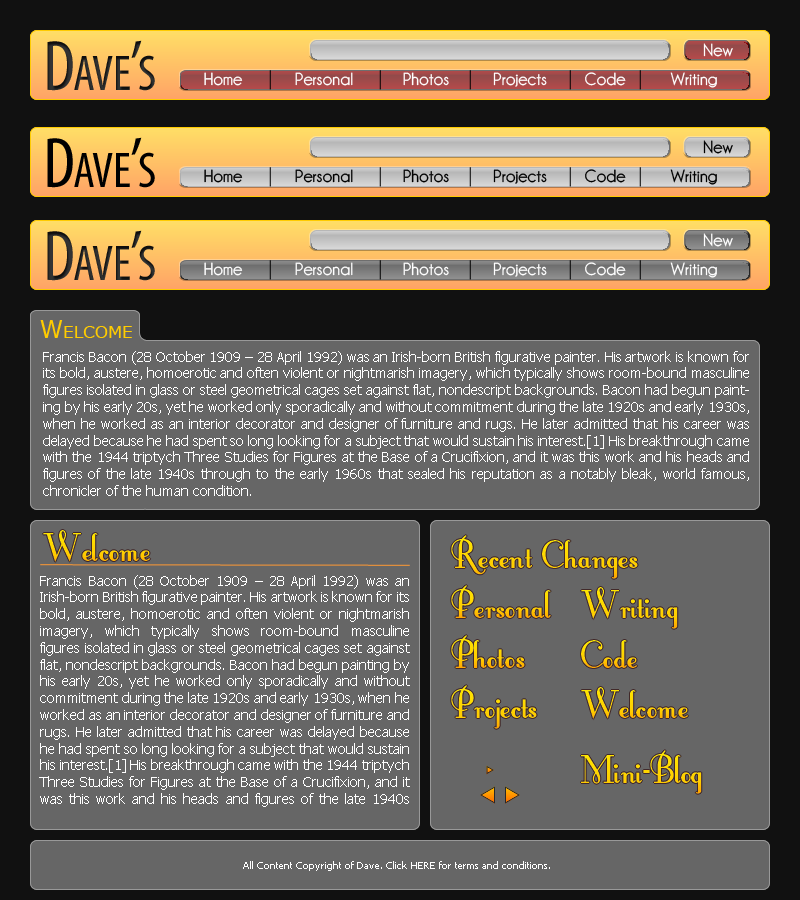
.psd file. The different header bar colours were intended for mouse-over effects which would use CSS’s hover ability to swap out the image, which felt like a cutting-edge trick at the time. There’s also a search bar, which was actually a later revision. I can’t seem to find the much simpler design that this was based on.The year is 2011 and I am doing a PhD at the University of Glasgow. PhD students are encouraged to have their own website so they can talk about their research and promote the research group. At the University of Glasgow, all our user accounts were set up with a folder that was served over the web via the department’s official domain. We didn’t have to use it though, and could host our own website if we preferred. When I could find the time around my other duties I started trying to figure out what I needed to do to pull together my own website instead. Life in general kept me busy, so progress was incredibly slow.
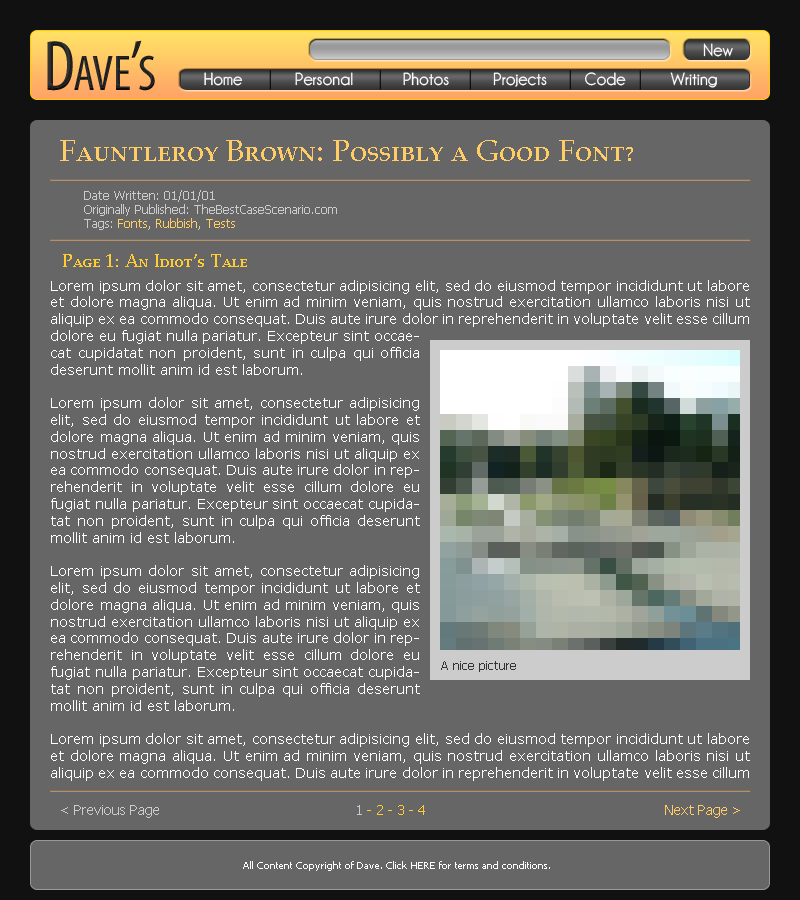
.psd file, this shows the changes I’d made to the design over time. The fonts changed. At this time the iPhone had been around for a little while, but i hadn’t really put much thought into a mobile layout, and I didn’t consider myself to have the resources to include that in my design. I’d made a conscious design to be desktop-only, basically.The year is 2012 and I am doing an internship in Barcelona at a major tech company. Away from my usual life and responsibilities, I decided now was the time to do a big push forward and finish the website. I did a lot of writing, updated the design and pulled a lot of things together. At the end of the internship I’d made a huge amount of progress. I essentially had everything in place. It worked. I could have, and should have, put it online. But for some reason… I didn’t. I told myself that it wasn’t perfect yet, that it needed more. Looking back I really don’t understand my reasoning here: fear of putting myself out there? Fear of rejection? I was purely doing it for myself, which certainly made it easier for me to believe whatever lie I was telling myself about not taking the next step. I don’t think I’ll ever understand what stopped me from going ahead and putting the website online at this point. Instead, I came back to Scotland and put up a placeholder website in its place, saying that I’d have my website online by summer 2013. That website remained in place until 2021.
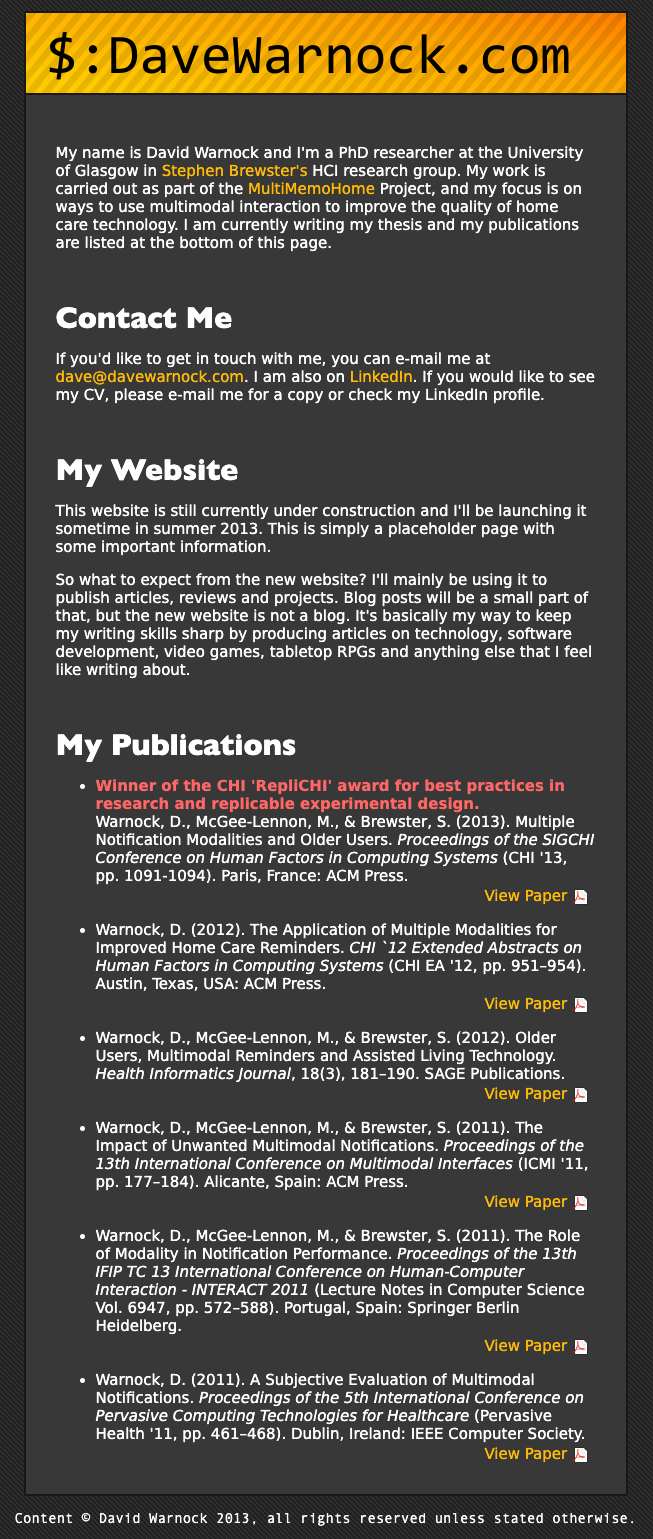
The year is 2017 and I am working as a software developer. I had not worked on the website in a long time. I’d set myself a goal several years ago, and come very close to reaching it. The fact that I hadn’t made me feel ashamed of the whole project, even though it was ostensibly almost complete. It had become a bit of a joke that my live website still read “coming soon, Summer 2013”. As it is with most things, it was a chance event that brought me back around to it. I’d been getting into tabletop RPGs in a really huge way for a long time. I was workshopping a session with a colleague in work, improvising characters around various plot ideas for a murder-mystery game I’d wanted to run. It had gone really well, and my colleague asked if I could share my notes so that they could run the session for their own group. “Sure thing”, I replied. Which got me thinking about that almost-finished website I had. Then I started thinking about all the things I’d written over the years, and all the work I had put in. I had so much content written, but I’d never managed to pull it all together. The spark was reignited, and I started trying to pick up where I’d left off. However, this was also the year my son was born. I was only able to devote a few hours a week to it, and progress was slow. Originally written in PHP 5, and starting with no plans for a mobile variant, it was hard to see a path forward with what I had.
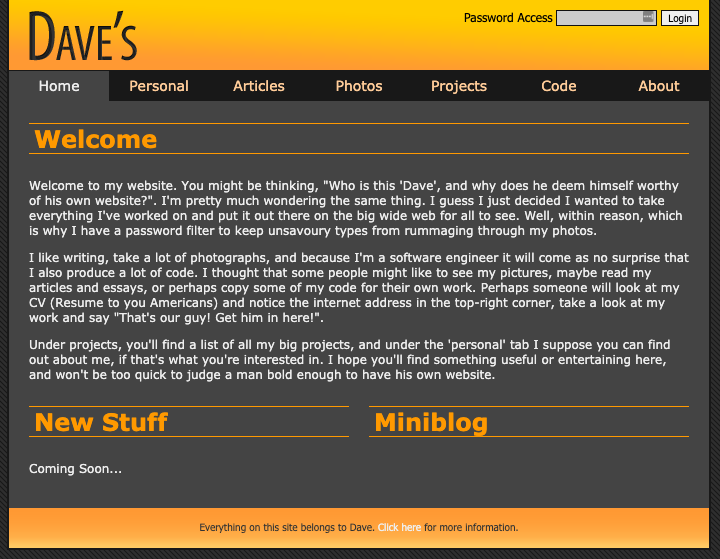
The year is 2018 and I am working as a software developer while adjusting to my new role as a parent. I was struggling with making progress on the website. I was toying with the idea of scrapping everything and starting again, but it seemed like such an awful idea. So much work down the drain. On the other hand, I had only ever done this for myself, so I wanted to take the path of greatest self-engagement, rather than the path of least resistance. I’d been reading up on Jekyll, a static site generator. The idea is to write articles in something like Markdown then run them through a processor that turns it into a website. While I liked the idea, Jekyll was written in Ruby, and I found the syntax too obtuse for something I wanted to work on as a hobby. Eventually I found Pelican, the same idea but written in Python. After messing around for a while I settled on that, and started thinking about styling. CSS toolkits had come a long way, and I’d found a simple pure-CSS toolkit called Spectre that I really liked, so I took that and started fiddling with it. I found several parts of both lacking, so I started adding my own code and systems. Progress was quick, even quicker than when I worked on it distraction-free in Barcelona in 2012.
The year is 2020 and the world is introduced to COVID-19. I’d made so much progress on the new website that it was essentially ready to go when COVID hit. I’d even managed to get back into writing, pushing myself to write about video games when I finished playing them. But I always seemed to find one more thing that wasn’t perfect. Excuse after excuse, it seemed to drag on with no end in sight. At one point I set up a Trello board to identify what I needed to do before launch. When I finished it, I just started randomly working on whatever took my fancy, telling myself it wasn’t perfect yet. When COVID hit, I started taking notes and created a journal. I started telling people about the website, and they contributed photos for this. When they asked when it would go online, I told them it wasn’t ready yet. One of my colleagues warned me: “don’t let perfect be the enemy of good”. I re-assessed what I really needed to do to get it online, and realised that everything was pretty much good to go as it was. Unfortunately the pandemic robbed me of all creative energy. Not only did any work on the website get stopped, but all my creative endeavours were shelved.
The year is 2021 and we are, I hope, in the final stages of the pandemic. I’ve seen my creative energy slowly start to come back. However, it wasn’t the website it came back to. Instead, my outlet was something so far out of my comfort zone that I think a global pandemic is the only way I’d ever have considered it: I started a twitch channel. For my first stream, I repaired a GameBoy Pocket that had no screen. Of course, I made a bunch of rookie errors. The audio was terrible, my lighting a joke. But I had fun and it was well-received. So I did it again the next week, and I’ve been doing it since.
I spent over a decade building a “perfect” website which has never seen the light of day. Then, one day on a whim I started streaming amateurish content on twitch and it’s been great. It grants a lot of perspective, and I feel like a fool for letting this drag on as long as it has. It’s time to publish.
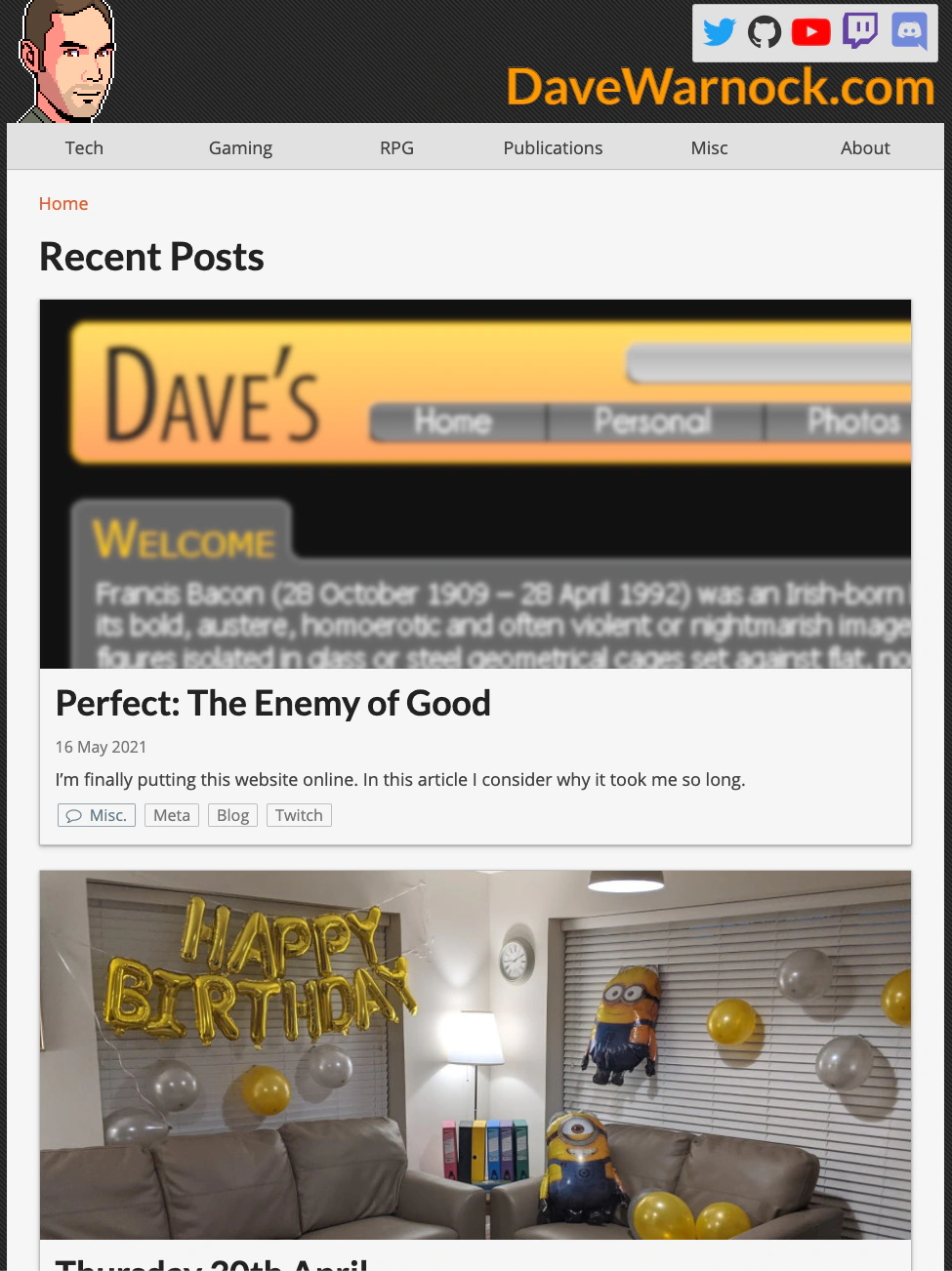
-
May 2001 Scientific American article “The Semantic Web”, Berners-Lee et al., May 2001. Scientific American. ↩
